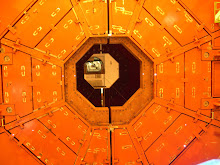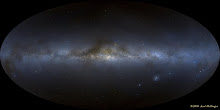 The first BEC, a rubidium-87, at 3 temperatures, 400nK, 200nK and 50nK, each pile of atoms 1 mm wide, activity greater nearer absolute zero, NIST 1995
The first BEC, a rubidium-87, at 3 temperatures, 400nK, 200nK and 50nK, each pile of atoms 1 mm wide, activity greater nearer absolute zero, NIST 1995In a familiar world of solids, liquids and gases, we find the fourth state of matter, the plasmas of lightning to the aurora borealis and fluorescent tubes at the office. Further out, minor phenomena becomes the big event in space, our shining stars are plasma being fused producing light. Not until 1924 was a fifth state of matter considered possible. Intrigued by quantum statistics, invented by the Bengali physicist, Satyendra Nath Bose from observations of light, Einstein applied Bose’s work to matter. The Bose-Einstein Condensate(BEC) was born. Was there any truth to the theory, Einstein himself wondered, that matter that could condense at ultracold temperatures into something new?
Einstein’s theory was left hanging, as a mathematical artifact, until 1938. Fritz London, a German theoretical chemist and physicist, working on helium at the same time as the Russian Pyotr Kapitsa who discovered its superfluid state at just under 2.2 K, found it behaved like Einstein’s theoretical BEC. Subsequent research confirmed London’s insight. Both stable isotopes, ordinary helium-4, and the rare helium-3 at much lower temperatures, are quantum superfluids, behaving like matter-waves or superatoms, undifferentiated matter with vastly different properties from their gas state or their ordinary bottled fluid state. Now scientists had a way of studying laboratory tabletop quantum physics. These, the only two superfluids known with zero viscosity, have sparked intense interest, helium-4 a bosonic superfluid and helium-3, a fermionic superfluid. Bosons are force carriers like photons of light and fermions are the matter we can touch. A gateway opened which eventually led to the laboratory production of other BECs when finally ultracold states could be induced, starting in 1995.
Viewing superfluid helium in action, demonstrates the baffling counter-intuitive nature of quantum fluids and other BECs. Some of the stunning properties of superfluid helium were observed if not understood back in 1908 when the Dutch physicist, Heike Kamerlingh Onnes, cooled helium-4 to -269 Celsius. Not only was there no resistance to flow, the superfluid could climb the walls of the vessel, like a film, always 30 nanometers thick, defying gravity, or pour through the smallest hole or fissure, or leak through some apparently non-porous matter.
Further studies showed that this superfluid, now called Helium II, behaved as a two-fluid model, partly in a low energy ground state, and partly in an excited state. With a little added heat and manipulation of the superfluid, an interaction of the two states was enhanced, producing a fountain effect, as though 2 fluids existed.
In our own Sun and countless other stars, hydrogen fusion produces helium, the second most abundant element, and is in turn eventually fused by steps into carbon-12. On Earth there isn’t much, a trace atmospheric gas but found in quantity up to 7 percent in some natural gas. It’s produced by nuclear decay, as from radium and polonium, dangerous alpha radiation releasing, in fact bare nuclei of helium that eventually pick up electrons and form stable helium isotopes.
Given an electric charge, helium can fluoresce like neon. Even rarer molecules of helium-3 have been produced in helium-4 during ionization. Superfluid helium is also a superconductor, 30 times more efficient than copper as well as a thermal conductor 300 times that of copper. And both helium-3 and helium-4 have been cooled to near absolute zero, helium-4 retaining its superfluidity, helium-3 crystallizing, yet still capable of movement like other BECs. Adding enormous pressure of 25 atmospheres and more, forces even helium-4 to act like other BEC ‘solids’.
If superfluid helium can tell us a lot about other ultracold BECs now being studied and produced by over 200 research teams worldwide, then BECs that also appear to be superfluids and have two coexisting states like the two fluid state of superfluids, could show us how superfluids behave. It’s more than satisfying the curiosity of pure research. BECs have been turned into atom lasers and BECs have produced bosenovas, an inexplicable phenomenon where BECs explode, releasing more than the energy present in the system and where about half of the BEC sample literally vanishes without a trace. Fascinating and worrisome in any lab working with small amounts of BECs, but superfluid Helium II BEC is being used in great quantities as a coolant in certain nuclear reactors and particle accelerators.
The possibilities of a giant BEC bosenova produced in superfluid Helium II haven’t been investigated. The matter is urgent as 120 T of superfluid Helium II are being used at the Large Hadron Collider at Geneva, whose energies far surpass any other collider’s, not only beam energies, but RF applied, extreme Tesla Fields by superconducting magnets, and electrical energies equivalent to the consumption of Geneva, powering the 27 km ring system. Startup of the LHC at 5 TeV per proton beam has been delayed to this September but for other technical reasons.
The problem too, is that BECs are new and strange. It wasn’t until 1995 that an ultracold BEC was produced by new methods of supercooling, in this case applied to a gas of Rubidium-87 to bring it near absolute zero. For physics it was a sudden explosion in the quantum world. A new field of study, Condensed Matter Physics, a new state of matter positively confirmed, but far from understood. Matter acting as one giant atom with the properties of a superfluid. Shared Nobel Prizes awarded in 2001went to the team leaders at JILA, the joint NIST project with CU-Boulder, Carl E. Weiman and Eric A. Cornell. A third share in the Nobel for a sodium-25 BEC developed independently went to Wolfgang Ketterle now at MIT. Research at MIT is on a massive scale with several big BEC labs, working in part on BEC atom lasers. Don’t worry, Ketterle has said, atom lasers only work in a vacuum and would only travel a meter without one. Nevertheless matter-wave lasers are bound to be improved. There’s always military interest and funding.
 A bosenova explosion of rubidium-85, from a new burstmovie by NIST, 2008
A bosenova explosion of rubidium-85, from a new burstmovie by NIST, 2008
Though the bosenova effect is staggering in its repercussions for the Standard Model, none of the more than 200 teams experimenting with BECs appear interested. The only study groups working seriously on bosenovas are those at JILA. Other research teams are looking for new BECs and a few are looking for applications of BECs to create things like better atomic clocks, interferometers or even studying light by teasing BECs with lasers to slow light down or stop it! In the future, quantum computing might use BECs and lasers. BECs could be big business.
What happens next at the LHC will be the next big experiment in a superfluid Helium II BEC. It’s not part of the design parameters, as physicists assume that the helium will be stable based on its use in the much smaller, much less powerful, up to 250 GeV per beam, RHIC collider in Long Island, NY. CERN’s interests lie in producing the Higgs boson at the LHC, perhaps micro black holes and quark-gluon plasma. Even in the much awaited CERN safety study released last month, there’s absolutely nothing on a possible bosenova implosion/explosion. Of course to test the safety of the enormous LHC to handle foreseen and unforeseen events you’d need another disposable one. But at least it is possible to subject Helium II to some of these high energies and hadron beams as a test. Not at the low energies of the RHIC, but at Fermilab’s Tevatron, currently the most energetic collider with 0.9 TeV per beam, though still far short of the power of the monster LHC at ordinary operating conditions of 7 TeV and ultimately 1,150 TeV collisions of lead ions at nearly twice light speed. Helium II could simply be used as a target by Tevatron beams to see what would happen, besides being exposed to high and fluctuating Tesla fields, ionized by electrical currents, subjected to some of the extreme conditions anticipated at the LHC.
The LSAG safety review at CERN, even their new report, is still a 4/5 majority internal assessment, and with an independent SPC Report/review of that review that’s still a CERN committee of 5 physicists, though the mainstream media is content with the CERN press releases, ‘No Danger That The LHC Will Destroy The Earth’, about everywhere. Though now black holes are now unlikely, but previously predicted to occur rapidly by CERN in the ‘LHC black hole factory’, but initially ignored, until a physicist wrote about the possibility in a letter to Scientific American that sparked the initial 2003 CERN safety assessment. There’s hard science and there’s French farce. Which one are we getting? Pushing the LHC big button as a test is a risky way to go. CERN has always insisted that small amounts of hadrons can’t do very much, but there’s an enormous amount of energy in the LHC and 120 T of BEC superfluid. There’s still a suit in the Hawaii courts to delay LHC startup because of safety concerns like black hole and strangelet production. Lately and since I first considered the possible dangers of superfluid helium in my article of March 7, 2008, ‘The Almost Thermonuclear LHC’, the plaintiffs, Dr Walter Wagner and Luis Sancho have announced they will seek an addendum to their suit to include bosenova risks at the LHC.
Seven years after the rubidium-85 BEC produced the first bosenova, we still don’t know what happened to half of the Rubidium-85 atoms that disappeared.
(This article originally appeared in the Alan Gillis Column, Big Science Gambles, published in ScientificBlogging.)
Baum, Michael. From Supernova to Smoke Ring: Recent Experiments Underscore Weirdness of the Bose-Einstein Condensate, NIST 2001
Boyle, Alan. Doomsday Under Debate, Cosmic Log, MSNBC 2008
Braun-Munzinger, Peter, et al. SPC Report On LSAG Documents, CERN SPC 2008
Claussen, N.R. et al. Microscopic Dynamics in a Strongly Interacting Bose-Einstein Condensate, JILA 2008
Donley, Elizabeth A. et al. Dynamics of collapsing and exploding Bose-Einstein condensates, JILA 2008
Ellis, John, et al. Review of the Safety of LHC Collisions, CERN LSAG 2008
Gillis, Alan. The Almost Thermonuclear LHC, The Science of Conundrums, 2008
Ketterle, Wolfgang. Ch 9, Bose-Einstein Condensation: Identity Crisis for Indistinguishable Particles, in “Quantum Mechanics at the Crossroads”, Springer Berlin, 2006
Schewe, Phil et al. Supersolid, Quantum Crystal, A Bose-Einstein Condensate in Solid, Physics News Update, The AIP Bulletin of Physics News, 2004
SuperfluidUploaded by reelgood0008 BBC Video
 Cointrin
Cointrin

























5 comments:
Excellent article. Professor Otto Rossler gave an interview recently expressing similar concerns that his safety arguments should be scientificaly debated and rebutted prior to experimentation.
Interview with Professor Otto Rössler, 20 Minuten News, June 25, 2008
LHCFacts.org
An excellent, and in-depth article! My comment is in direct regard to this article, and the CERN LHC/ALICE/ATLAS pending discoveries, from the 2009-2019 pre-planned precision energy upgrade experiments. If the LHC is long-term successful, then not only the discovery itself should be examined, but also the ramifications upon the world of physics and industry! When I read about the Superfluids, BEC's, Bosenovas, just like the Higgs Boson, Supersymmetry Particles, Quark-Gluon Plasma, Superstrings, Multi-Dimensions, and perhaps even Time itself, I keep getting a visualization of the future application of these, and the many other discoveries to come. My personal speculations are: Astrophysics - the answers to the accelerating universe perception, the closed geometrical configuration of our Universe, (M)/Brane Theory, and the Big-Bang, but all this and more shall be applied to the immediate tasks at hand, as well as to the near/distant future human needs! A controlled and sustainable Nuclear Fusion process for our future desperate energy needs! Plasmatic Fusion Drive-Reactors for interstellar spaceflight! The ability to increase control and energy outputs from superconductivity and solar beam technologies, with an inter-mix of both, with a lesser input ratio! Transformations of Light, Microwaves, Electron Beams, etc.. into each others respective forms, and back again. Teleportation and Invisibility with extreme stability. I suppose as I look to the distant future, after the completion of the Standard Model, and the haze of mathematical confusion lifts, the unified equation may look like: Space = Time = Energy = Mass, and ALL is interchangeable. I will not try to touch upon every possibility, because this comment is intended to stimulate the readers' instinctual imagination! I will predict however, an entirely 'new' branch of energy physics, surrounded by Plasmatic Luminosity, Molecular, Nuclear, and Quantum theory, with an unimaginable unifying outgrowth potential!
CERN judging their own LHC is safe is like a drunk deciding he's all right to drive... with 6,700,000,000 passengers.
Who cares about a Higgs Boson particle or some quark gluon goop except a handful of frustrated geeks who have run out of ideas and have to experiment with forces they don't even understand. These freaking physicists waste money and energy time and time again building atom smasher after atom smasher and end up with more questions, not answers. Now they've built one so powerful they say themselves it will create mini black holes at the rate of one per second! Which would change your life more; knowing they found some particle or getting crushed and sucked into a black hole along with everyone and every thing you ever cared about?
That sound like a good risk vs. benefit to you?!? Just because you can't wrap your mind around it does not mean it can't happen.
See for yourself;
http://www.risk-evaluation-forum.org/anon1.htm
http://www.LHCDefense.org/
http://www.LHCFacts.org
http://www.SaneScience.org/
Popular Mechanics - "World's Biggest Science Project Aims to Unlock 'God Particle'" - http://www.popularmechanics.com/science/extreme_machines/4216588.html"
JTankers links to the same 20 Minuten article on Dr Rössler, the A golf ball comment and the earlier Interview comment, only give you the German original. The so-so Google Translate for English, after some Google rummaging around, is to be found here for the Rössler news story: http://translate.google.com/translate?hl=en&sl=de&u=http://www.20min.ch/print/story/24668213&sa=X&oi=translate&resnum=2&ct=result&prev=/search%3Fq%3D%252220%2Bminuten%2522%2BRossler%26hl%3Den
The same link error occurs on the LHCfacts website, where you can find the latest on the Wagner/Sancho suit to delay LHC start-up until there has been an independent safety review, plus other useful info and criticism of the LHC, with more on Professor Rössler.
I’ve been planning to do an article on his work, in English or French, and I’d appreciate his email address. JTankers or Robert Marsh, if you have it or can get it, send it to me in an email, and not a comment, respecting his privacy.
Both of you comment a lot on LHC sites and blogs, and your ideas are intriguing. You ought to expand on them so we could have a platform for discussion. Possibly, you could publish your articles here, on The Science of Conundrums.
As an "almost" complete layperson in matters of particle physics, I do however see a philosophical approach to the LHC experiment which should be discussed.
Even if this current experiment does not lead to the creation of a space stationary black hole that does not evaporate (and thus logically, as a gas only expands because that's the only way the molecules can go, will grow), the possibility that the next such experiment, or the one after it may lead to the end of space and time for us must be seriously discussed by the scientific and non-scientific community.
It is entirely possible that the odd findings of SETI and other quests to discover extraterrestrial communications are directly linked to such experiments.
The fact that no extraterrestrial artificial signals are found can be well explained by considering that any advanced civilisation which develops the ability to send detectable interstellar signals, whether willingly or unwittingly, will have developed, within a relatively short time-frame (similar to that between Marconi's successes and the LHC experiment), technologies to create stationary black holes. If it is inevitable that they will discover such experiments (and it seems likely if we assign them the attribute of scientific ability and interest which enables technological communication)the thought must turn to the presumption that all civilisations that developed technologies before us would have also done this very experiment before us. Then why aren't they out their. I worry that the answer might be that all these civilisations push the boundaries of their experimentation until they "commit" an experiment that destroys time and space for them and their region of the universe.
It is very valid to point out that all naturally created black holes will not be stationary in regards to the earth. After all they are the result of matter and energy rich processes which, in an ever moving universe, are always more likely to be in contrary motion in respect to the earth.
Even if they circled around our solar system or within the core areas of the galaxy or universe, they would be governed by Newtonian physics in regard to their position within such systems. Much as the moon is benign to us because of the centrifugal (centripetal?) forces that keep it on a steady track. If, however, for example, we made the moon stationary on the earth's surface, it would certainly destroy the current fragile development of life on earth and would massively disrupt the geophysics of the planet. A stationary black hole (in respect to an inhabited planet) is surely not naturally possible.
Perhaps we are the first civilisation that can escape the inevitable conduction of the last experiment. If not, we must do all in our powers to create a warning beacon (probably from the remains of our regional matter under the effect of the black hole) for other civilisations on the brink of trying these experiments.
Indeed, perhaps there are already many such beacons out there and we have not been able to decipher them, or the demised civilisation was not left with enough time to install them adequately.
I hope this provokes some thought.
Frank
Post a Comment